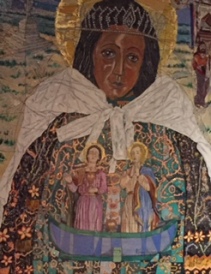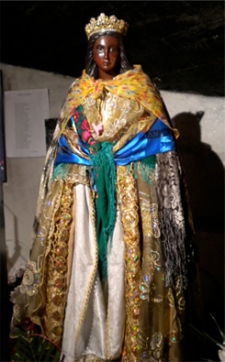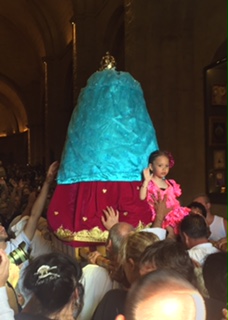
O Sainte Marie-Jacobe, priez pour nous.
O Sainte Marie-Salome, priez pour nous.
O gardeures de la Provence, priez pour nous.
The priest intoned the words in deep, liquid accents, his voice echoing from the ancient stone church in the remote village of Les Saintes-Maries-de-la-Mer, in the Camargue region of Southern France, where the waters of the Rhone River meet the Mediterranean Sea in a wild, wide, flat expanse populated by black bulls, pink flamingos, and white horses.
“O, Saint Mary-Jacobe, pray for us.”
“O, Saint Mary-Salome, pray for us.”
“O, guardians of the gates of Provence, pray for us.”
I could feel the words resonating through me, bringing sudden, hot tears. The people gathered in the small village square repeated the priest’s chant, their voices rising above the low, white-washed houses into the sunlit sky, out towards the shimmering sea where legend tells us the two Marys had drifted two thousand years ago in a boat without rudder or sail.
Mary-Jacobe and Mary-Salome were the Marys who, along with Mary Magdalene were said to have brought unguents to the tomb of Christ; later cast into the sea by the Romans, they washed up near the mouth of the Petit Rhone, bringing Christianity to France. Their relics, unearthed in 1448, are enshrined in a high chapel in the village church, Notre Dame de la Mer.
It was Sunday, October 19th, 2014, and my companion and I had stumbled upon the conclusion of Marie-Salome’s annual procession, when the relics are lowered into the church’s nave and the statues of the two Marys in their boat are carried to the sea. A second procession, for Marie-Jacobe, is held each year on May 25th.
The Nacioun Gardiano–men in black velvet jackets and wide-brimmed black hats, the keepers of the bulls and the traditions of the Camargue–perched high atop white horses lined up in two rows before the opened church doors, each man holding a long wooden pole crowned by metal prongs in the shape of bull horns. Women in traditional Camarguaise garb–full skirts, tight bodices, and pinned headdresses–stood in groups, holding the hands of traditionally-dressed young girls. People of all ages crowded behind the gardians, peering into the crowded church.

We were here because we had impulsively decided to return to Les Saintes-Maries-de-la-Mer on the final day of our brief trip to Southern France. The village had been deserted the previous week, and we were anticipating a quiet walk by the sea. But as we drove south on the narrow road from Arles, we found ourselves in a long line of slow-moving traffic; when we heard church bells ringing and ringing, we remembered: the procession! We had read about it, but expecting to be elsewhere that Sunday, we had put it out of our minds. Unconsciously, we had answered the call summoning us back to this ancient, sacred place.
Built between the tenth and twelfth centuries, Notre Dame de la Mer is believed to occupy the site of an older Christian sanctuary, as well as a temple to Artemis–and perhaps also a Mithraeum, dedicated to the Persian/Roman sun god Mithra, the bull-slayer. Beneath its nave is a freshwater spring, celebrated for its healing powers. Our local hostess had told us about a Black Madonna in the church’s crypt, and we had gone to see Her on our first visit.

In the crypt, hundred of candles burned, perfuming the small space and making it almost uncomfortably warm. The low arched ceiling was blackened with soot. The statue, adorned in multi-colored silks, was surrounded by flowers and small objects left in gratitude. But this “Black Madonna” is not a Madonna at all; instead, She embodies Sara, a mysterious figure associated with the two Marys.
“La Sainte Sara,” She is called, though She is not an official Catholic saint. Yet She too has Her holy day, May 24th, Her own procession and pilgrimage. In one version of Her story, She was the servant, perhaps Egyptian, of Marie-Jacobe and Marie-Salome, cast with them into the sea. In another, She was an indigenous inhabitant of the Camargue, a priestess some say, who welcomed and aided the two Marys. And according to influential twentieth-century Camargue writer and activist, Folco de Baroncelli, She was a Gitan, a local Gypsy, who cared for and was converted by the Marys.
Although Gypsies are believed to have entered Europe only after the 15th century, Baroncelli’s theory makes a certain poetic sense, for no one can otherwise explain why Gypsy peoples–Gitans, Manouches, Roms (or “Gens de Voyage” as the French call them)–travel by the thousands from throughout Europe to Les Saintes each May to pay homage to Sara.

Some scholars have identified Sara with the Hindu Goddess Kali, whose rituals Gypsies might have brought with them when they migrated to Europe from India. According to Sophie Bergaglio‘s authoritative new book, documented evidence of Gypsy presence during the May pilgrimage dates to the 1850s. The statue of Sara appeared in 1904, and Her first procession to the sea was authorized in 1935, although church officials did not participate until 1967. Today, the local church, including the Archbishop, is fully involved, celebrating Sara and welcoming the Gitans. As Bergoglio puts it, “The Gypsy people created a Saint.” Or, as Baroncelli would have it, Sara unites in Herself indigenous pagan and Christian beliefs and practices.

And so, when I found myself able to return to the Camargue this year, I scheduled my trip to coincide with the May pilgrimage: I wanted to join the celebration of this Goddess figure who inspires such passion in Her devotees. This time the village streets were lined with Gypsy caravans: not the colorful “roulottes” scattered in the fields as painted by Van Gogh, but white motor homes carefully parked in designated spots. In Sara’s candle-lit crypt, a steady stream of men, women, and children reverently approached to caress, dress, and thank Her; once more, my tears welled. On the day of the procession, I followed Her to the sea and returned with Her to the church, grateful to be present at a true theaphany, a deep experience of Goddess in the World. As in the liminal landscape of the Camargue, where sea, earth, and sky meet and intermingle, all boundaries dissolve.
Here at Les Saintes-Maries-de-la-Mer, I was reminded of how I felt when I first stepped onto the grounds of the monastery at Paliani on Crete–also an ancient Christian site that holds memories of more ancient Goddess worship. While I have participated in many small Goddess rituals, both before and since, only at these two places have I been present at an event where so very many people–men, women, and children–were entirely focused on Her. Her presence was palpable to me.
Vive les Saintes Maries!
Vive la Sainte Sara!
 Joyce Zonana is the author of a memoir, Dream Homes: From Cairo to Katrina, An Exile’s Journey. After participating in Carol Christ’s Goddess Pilgrimage to Crete in 1997, she served for a time as Co-Director of the Ariadne Institute for the Study of Myth and Ritual. She teaches writing and literature at Borough of Manhattan Community College and is currently completing a translation from the French of Henri Bosco’s Malicroix, a novel set in the Camargue.
Joyce Zonana is the author of a memoir, Dream Homes: From Cairo to Katrina, An Exile’s Journey. After participating in Carol Christ’s Goddess Pilgrimage to Crete in 1997, she served for a time as Co-Director of the Ariadne Institute for the Study of Myth and Ritual. She teaches writing and literature at Borough of Manhattan Community College and is currently completing a translation from the French of Henri Bosco’s Malicroix, a novel set in the Camargue.


In the last picture I take it that the statue is covered and the little girl is reflecting her power? Can you explain?
LikeLike
From what I understand, every year a young girl is chosen to represent Sara . . . she is carried with Her to the sea and back; Sara Herself is dressed in elaborate robes–we’re seeing Her from the back in this photo.
LikeLike
The “girl Goddess” is also an echo of Hindu practices.
LikeLike
http://escritoreversoncampos.blogspot.com.br/?view=magazine
LikeLike
Thanks, Joyce! On “La Sainte Sara” — Since it’s my name I’ve done research on the derivation of SARA or SARAH. It is actually built from SAR (or that is, czar) plus the feminine ending, so it means literally a female czar or leader or monarch. It can also be translated as princess or noblewoman, in Hebrew.
LikeLike
Perfect!
LikeLike
Thanks, Joyce. I have yet to experience a Christianized goddess procession, although I’ve read about several. I’m sure that tears would come to my eyes as well. Thanks for the description.
LikeLike
Thanks, Nancy, for your comment . . . Yes, it’s an extraordinary thing to experience. I hope you’ll have a chance.
LikeLike
Thanks for describing your experiences so beautifully. I learned about the ceremonies at Les Saintes-Maries-de-la-Mer just a few years ago. Hope to make it there some day.
LikeLike
Hope you do too, Judith! It’s a wonderful experience.
LikeLike